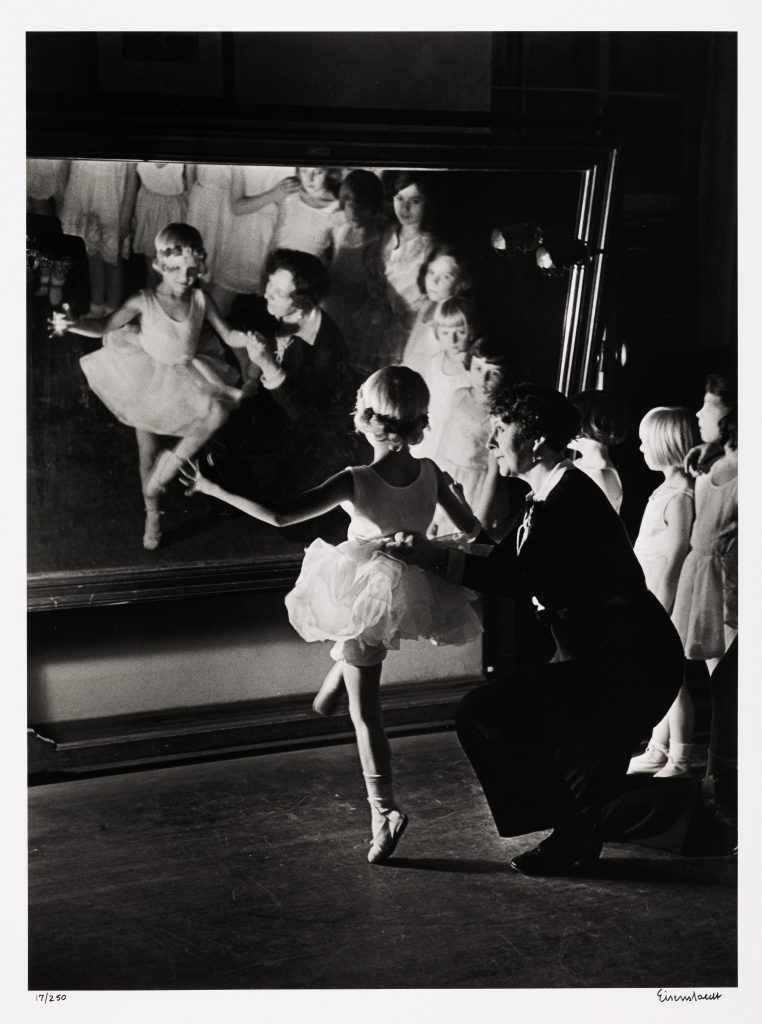Alfred Eisenstaedt (1898-1995)
First Lesson at Truempy Ballet School, Berlin, 1930
Gelatin silver print
Courtesy of the Leonid and Tatiana Nevzlin Collection
The German-born photographer and photojournalist Eisenstaedt gained recognition as a staff photographer for Life magazine after moving to the U.S. His photographs capture pivotal moments and events that shaped the modern world, ranging from Hitler and Mussolini’s first meeting, through the aftermath of the atomic bombing of Hiroshima, to post-Depression era America. he was also known for his portraits of luminaries, and everyday life.
Must Know
Alfred Eisenstaedt, or “Eisie,” as his friends called him, was born of well-
to-do parents in Dirchau, West Prussia (now part of Poland), in 1898.
he studied at the University of Berlin and served in the German army during World War I. After the war, while employed as a button and belt salesman in Berlin, he taught himself photography and worked as a freelance photojournalist. In 1929, he received his first assignment that would launch his professional career–the Nobel Prize ceremony in Stockholm.
Narrowly escaping the Holocaust in Europe Eisenstaedt emmigrated to New York in 1935. . After presenting some of his recent work, he was hired at LIFE MAGAZINE in 1936 and stayed there until his death in 1995
Over his career Eisenstaedt photographed a diverse range of subjects ranging from the first meeting between Hitler and Mussolini, the aftermath of the Hiroshima bomb, and post depression America, to portraits of John F Kennedy, Albert Einstein, and Marilyn Monroe, to enduring photographs of ordinary people across America and Europe. As diverse and disparate as Eisenstaedt’s photographs are, all of these images are unified by Eisenstaedt’s continually fresh eye and talent for capturing pivotal moments in the human experience. Among the first to use a 35mm camera, Eisenstaedt took candid photographs with available light and helped to define the art of photojournalism. His pictures let people and events speak for themselves. His job was to find and catch the storytelling moment.
Considered the father of photo journalism, Eisenstaedt has been given a multitude of exhibitions, awards, and medals. Up until his death in 1995, Eisenstaedt was still shooting and adding to his inventory of over 100,000 negatives in his personal office at LIFE magazine.
In this early Pre-war German photograph at the Treumpy Ballet school in Berlin he catches the young dancers in class. Similiar to the Impressionist painter Edgar Degas, what seems to inspire Eisenstaedt is the behind-the scenes, casual candid moments of dancers rehearsing or resting. here he captures the gaze of the young pupils on the one dancer in front of the mirror. he considered himself a documentary photographer, capturing reality and recording what he sees.
he is known for saying: “It’s more important to click with people than to click the shutter.”

